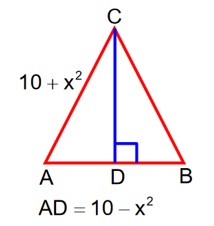31. On which of the following intervals is the function f given by f(x) = x100 + sin x –1 decreasing ?
(A) (0,1) (B) (C) (D) None of these
31. On which of the following intervals is the function f given by f(x) = x100 + sin x –1 decreasing ?
(A) (0,1) (B) (C) (D) None of these
-
1 Answer
-
We have, f (x) = x 100 + sin x - 1.
So, f (x) = 100x99 + cosx.
(A) When x (0,1). We get.
x>0
x99> 0
100 x99> 0.
Now, 0 radian = 0 degree
and 1 radian =
So, cosx> 0 for x∈ (0,1) radian = (0,57)
∴f (x) > 0 for x∈ (0,1).
(B) When x ∈ we get,
So, x> 1
x99> 1
100x99> 100.
And cosx is negative between -1 and 0.
So, f (x) = 100x99 + cosx> 100 - 1 = 99 > 0.
∴f(x) is strictly increasing on
(c) When x ∈ we get,
x> 0
x99> 0
100x99> 0
and cosx> 0. (firstquadrant).
I e, f(x) > 0.
∴f(x) is strictly increasing on
Hence, option (D) is correct.
Similar Questions for you
y (x) = ∫? (2t² - 15t + 10)dt
dy/dx = 2x² - 15x + 10.
For tangent at (a, b), slope is m = dx/dy = 1 / (dy/dx) = 1 / (2a² - 15a + 10).
Given slope is -1/3.
2a² - 15a + 10 = -3
2a² - 15a + 13 = 0 (The provided solution has 2a²-15a+7=0, suggesting a different problem or a typo)
Following the image: 2a² - 15a + 7 = 0
(2a - 1) (a - 7) = 0
a = 1/2 or a = 7.
a = 1/2 Rejected as a > 1. So a = 7.
b = ∫? (2t² - 15t + 10)dt = [2t³/3 - 15t²/2 + 10t] from 0 to 7.
6b = [4t³ - 45t² + 60t] from 0 to 7 = 4 (7)³ - 45 (7)² + 60 (7) = 1372 - 2205 + 420 = -413.
|a + 6b| = |7 - 413| = |-406|
f' (c) = 1 + lnc = e/ (e-1)
lnc = e/ (e-1) - 1 = (e - (e-1)/ (e-1) = 1/ (e-1)
c = e^ (1/ (e-1)

Area
3x2 = 10
x = k
3k2 = 10
By truth table
So F1 (A, B, C) is not a tautology
Now again by truth table
So F2 (A, B) be a tautology.
From option let it be isosceles where AB = AC then
=
Now ar
then
So .
Hence be equilateral having each side of length
Taking an Exam? Selecting a College?
Get authentic answers from experts, students and alumni that you won't find anywhere else
Sign Up on ShikshaOn Shiksha, get access to
- 65k Colleges
- 1.2k Exams
- 679k Reviews
- 1800k Answers
